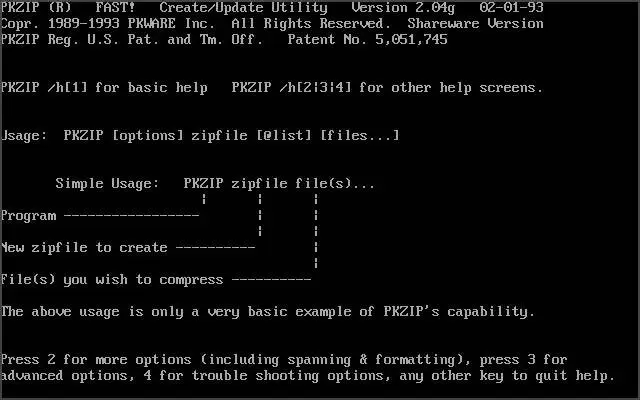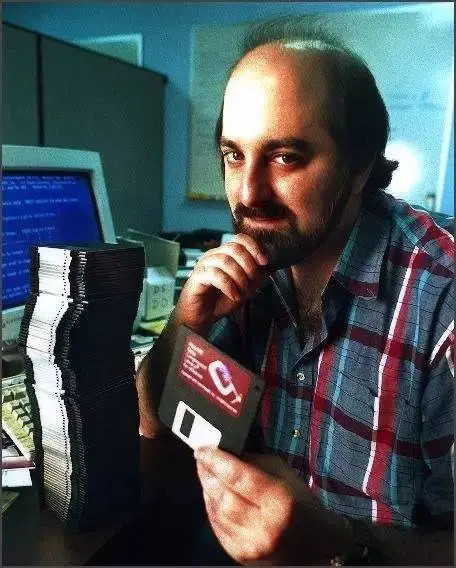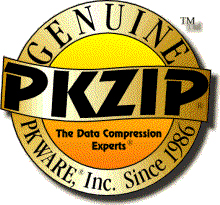
A PKZIP egy olyan szoftverprogram neve, amelyet eredetileg a DOS (Disk Operating System) környezetben fejlesztettek ki a számítógépes adatok tömörítésére és kicsomagolására. A PKZIP története a 1980-as évek közepére nyúlik vissza, amikor Phil Katz nevű programozó létrehozta az első verziót.
Az elnevezés eredete a "PK" mozaikszóból származik, amely Phil Katz nevének rövidítése. A "ZIP" pedig a tömörített fájlok kiterjesztésére utal. A PKZIP egyike volt az első olyan szoftvereknek, amelyek lehetővé tették a fájlok tömörítését, hogy kevesebb tárhelyet foglaljanak el a merevlemezeken, valamint a fájlok gyorsabb továbbítását az interneten vagy más adathordozókon.
A PKZIP népszerűvé vált a PC felhasználók körében, mivel hatékony és könnyen használható eszközt kínált a fájlok tömörítésére és kicsomagolására. Az eredeti verziók esetében a .ZIP kiterjesztésű fájlok széles körben elfogadottak lettek, és ezt az elfogadott formátumot más tömörítési szoftverek is támogatni kezdték.

ZIP fájlkiterjesztés 1989-ben jött létre, mint a PKZIP program saját formátuma. A PKZIP-t Phil Katz mutatta be (további közreműködő Gary Conway volt), egy olyan jogi per után, amelyet a korábban népszerű ARC program (és fájlformátum) készítői indítottak ellene szerzői jogi és védjegysértés miatt, egy korábban Phil Katz által készített PKARC program miatt, amely kompatibilis volt az ARC formátummal. Ennek eredményeként Katz létrehozott egy új fájlformátumot, amely gyorsan népszerűbbé vált, mint az ARC. Ez részben annak köszönhető, hogy a hírlevélrendszer [BBS] rendszergazdáknak, akik akkoriban ezt a tömörítőt használták és ellenezték a ARC fejlesztőjének Phil Katz szemben indított perei miatt. Számos programot fejlesztettek különböző operációs rendszerekre, amelyeket a ZIP fájlok tömörítésére és kicsomagolására használhattak a felhasználók, és a formátumot natív támogatás is beépítették néhány népszerű operációs rendszerbe is.
A PKZIP és az ehhez hasonló tömörítő szoftverek mára általánosak és elterjedtek lettek, és fontos szerepet játszanak a fájlok tárolásában és továbbításában a digitális korban.
Katz 1986-ban távozott az Allen-Bradley vállalattól, hogy a Graysoft nevű, Milwaukee-i szoftvercégnél kezdjen el dolgozni. Ekkor dolgozott a Thom Henderson által készített ARC tömörítő alternatíváján, melyet PKARC néven lett ismert. Az ARC C nyelven íródott, és forráskódja elérhető volt a System Enhancement Associates (SEA) hírlevélrendszerén (BBS). A PKARC részben gépi kódban íródott, és jóval gyorsabb volt. Katz különleges tehetséggel rendelkezett a kód optimalizálásában: a kritikus részeket gépi kódben írta, és C kódot is írt ugyanarra a feladatra több különböző módon, majd megvizsgálta a fordító kimenetét, hogy megtudja, melyik produkálja a leghatékonyabb gépi kódot. Először csak a PKXARC-ot, egy kicsomagoló programot, tette közzé ingyenesen. Sokkal nagyobb sebessége miatt gyorsan elterjedt a BBS közösségben. Pozitív visszajelzések és bátorítás ösztönözte Katzt arra, hogy kiadja tömörítő programját, a PKARC-ot, és végül shareware-é tegye a szoftvert. Katz 1986-ban alapította a PKWARE, Inc.-t (Phil Katz Software), melynek működése Glendale, Wisconsin-i otthonában működött, de továbbra is dolgozott a Graysoft-nál egészen 1987-ig. Steve Burg, egy korábbi Graysoft programozó, 1988-ban csatlakozott a PKWARE-hez.
Az 1980-as évek végén vita robbant ki a System Enhancement Associates (SEA), az ARC program készítője, és a PKWARE között. Az SEA jogi eljárást indított Katz ellen a védjegy- és szerzői jogsértés miatt. A tárgyaláson a legmeggyőzőbb bizonyíték egy független szoftverszakértő, John Navas állásfoglalása volt, akit a bíróság nevezett ki a két program összehasonlítására. Navas kijelentette, hogy a PKARC az eredeti ARC származékos művének eredménye, rámutatva, hogy mindkét programban gyakran azonosak voltak a megjegyzések, beleértve az elírásokat is.
1988 augusztus 2-án a felperes és a alperesek bejelentették a perrel kapcsolatos megállapodásukat, amely magában foglalta egy bizalmas keresztengedélyezési megállapodást is. Ennek értelmében az SEA engedélyezte a PKWARE számára az összes ARC-kompatibilis programra vonatkozó engedélyeket, amelyeket a PKWARE a PKXARC 1985 végén történt első kiadásától kezdve 1988. július 31-ig kiadott. Cserébe a megállapodás szerint a SEA részére az PKWARE megfizeti a licencdíjakat. A PKWARE hozzájárálást adott a SEA számára, hogy felhasználhassa a forráskódját az PKWARE ARC-kompatibilis programjaihoz. A megállapodás az is része volt, hogy PKWARE leállítja az SEA „ARC” védjegy használatát, és megváltoztatja a PKWARE programjaiban használt neveket vagy védjegyeket, hogy ne okozzon kavarodást. Az egyezség részletei zártak maradtak. Az egyezség megkötésekor az alperesek nem ismerték el bűnösségüket vagy hibájukat. A wisconsini bírósági rendelkezés szerint az alpereseknek kártérítést kellett fizetniük a felperesnek az alperesek cselekedeteiért. Az alpereseket azzal vádolták, hogy sértették a felperes szerzői jogait, védjegyet sértettek, és tisztességtelen kereskedelmi gyakorlatokat és tisztességtelen versenyt folytattak.
A kiszivárgott megállapodás dokumentumából kiderül, hogy az egyezség értelmében az alperesek 22 500 dollárt fizettek a felperesnek a korábbi jogdíjakért és 40 000 dollárt költségtérítésekért. Ezenkívül az alperesek a megállapodás hatályba lépése után az összes beérkezett rendelési bevétel 6,5%-át fizetik a felperesnek az ARC-kompatibilis programokokra vonatkozóan. Az ilyen bevételek magukban foglalják az engedélydíjakat vagy a shareware regisztrációkat is, amelyek a licenc lejárta után érkeznek az ARC-kompatibilis programokra. Cserébe a felperes is fizet 6,5%-os jutalékot bármely engedélydíjra, amit a felperes bármely engedélyezett félnek fizet az általuk hivatkozott engedélyezőtől, a licenc lejárta előtt, és akár utána.

A per után a PKWARE kiadott egy utolsó verziót a PKARC és PKXARC segédprogramjaiból az „PKPAK” és „PKUNPAK” új nevek alatt. Ezután a PKZIP és PKUNZIP önálló programok fejlesztésére koncentrált, amelyek új és az ARC-tól eltérő fájltömörítési technikákon alapultak. Az átnevezés után az SEA ismét pert indított a PKWARE ellen újabb büntetést remélve, mert az folyamatosan használta az „ARC” védjegyet, a PKPAK kézikönyvében az ARC névszót főnévből igévé alakítva. Az Amerikai Egyesült Államok kelet-wisconsini kerületi bírósága kimondta, hogy az SEA kérelme elutasításra került, és a alperes jogosult volt a 500 dolláros jogi költségek megtérítésére.
Az SEA vs. PKWARE vita gyorsan az egyik legnagyobb vitává vált, amit a BBS világ valaha látott. Az SEA pereskedése sok shareware felhasználót felháborított, akik úgy érezték, hogy az SEA egy „nagy és szemtelen vállalat”, míg Katz "a kisember". Valójában abban az időben mind az SEA, mind a PKWARE kis otthoni cégek voltak. Az közösség azonban nagyrészt Katz oldalára állt, mert az SEA próbálta utólag zárt és szabadalmazottá tenni az ARC fájlformátumot. Katz pozitív sajtót kapott azáltal, hogy nyilvánosságra hozta az APPNOTE.TXT specifikációt, amely dokumentálta a Zip fájlformátumot, és kijelentette, hogy a Zip fájlformátum mindig ingyenes lesz a versenytárs szoftverek számára is. Ennek eredményeként az ARC formátum gyorsan kikerült a közös használatból, például a BBS-ek fájltárai által használt tömörítési formátum. Ezek után egy rövid verseny időszakot követően a Zip formátum vált a meghatározó szabvánnyá.
Videósorozat a BBS-ek világáról
A BBS (Bulletin Board System) közösség egy keveréke volt az régivágású számítógépes programozóknak és azoknak, akik épp most kezdték felfedezni a számítástechnika világát. Ez a környezet ideális volt Phil Katz számára, egy fiatal programozó számára, aki Glendale-ben született és nőtt fel, Wisconsin államban.
Barátai és kollégái, például Doug Hay, úgy írják le Katzt, mint aki társaságban kicsit szociálisan ügyetlen, de rendkívül intelligens személyt. Tehetsége itt virágzott ki, ebben a közösségben, ahol az emberek a számítástechnika alapjait teremtették meg, és ami később a társadalmunk egyik alapkövévé vált. Természetesen ehhez a számítógépeknek elérhetőbbnek kellett válniuk, és akkoriban az egyik fő probléma egyszerűen az információ átvitele volt különböző számítógépek között.
Amikor egy fájlt szerettél volna átvinni, mondjuk egy szövegszerkesztő programot szerettél volna letölteni, ami akár 80 fájlból állt, amit le kellett töltened. Eredetileg a hírlevélrendszerben (BBS) 80 különálló fájlt kellett letöltened, és ez igen kellemetlen és lassú volt. A tömörített formátumában elérhető fájlok kisebb helyet foglaltak és csak egyetlen fájlt kellett letölteni.
Az SEA versus PKWARE vita nemcsak jogi, hanem szélesebb körű közösségi vitává vált, és mély hatással volt a fájltömörítés és a szoftverek területére. Az ügy magában hordozott fontos jogi és etikai kérdéseket arról, hogy ki és milyen mértékben használhatja fel más szoftverek forráskódját és algoritmusait az új szoftverek fejlesztése során. Továbbá a vita rámutatott a szoftverek fájlformátumainak szabványosításának fontosságára és az offentúrás szoftverek használatának terjedésére.
Phil Katz pozitív megítélése azáltal, hogy megosztotta a Zip fájlformátum specifikációját és hagyta, hogy más szoftverfejlesztők is használják, hozzájárult a Zip formátum elterjedéséhez, és a mai napig egyike a legelterjedtebb és legfelhasználóbarátabb fájltömörítési formátumoknak.

Sajnálatos módon Phil Katz tragikusan fiatalon, 37 éves korában elhunyt 2000-ben. Azonban az általa létrehozott PKZIP és ZIP formátum még mindig széles körben használt tömörítési módszer a mai napig.
Phil Katz hosszú éveken át küzdött az alkoholizmussal. Az első ismert letartóztatása 1991-ben történt. Nagyjából egy évvel később Katzt ismét ittas vezetésen kapták és ítélték el. 1994 és 1999 szeptembere között ötször is letartóztatták, mert vezetett a vezetéstől való eltiltás és jogosítványának bevonása ellenére.
Katz halála előtt az Ozaukee megyei seriffhivatal több körözést is kiadott ellene, beleértve a letartóztatás megszegését, valamint ittas vezetés és jogosítvány-eltiltás elleni vádakat.
2000. április 14-én, 37 éves korában Katz-t egy hotelszobában találták meg, üres pezsgősüveggel a kezében. A halotti anyakönyvi kivonat szerint a krónikus alkoholizmus okozta vesztét, halálát akut hasnyálmirigy vérzés okozta.
Az APPNOTE.TXT, amelyben a ZIP fájlformátum dokumentálva volt:
Disclaimer
----------
Although PKWARE will attempt to supply current and accurate
information relating to its file formats, algorithms, and the
subject programs, the possibility of error can not be eliminated.
PKWARE therefore expressly disclaims any warranty that the
information contained in the associated materials relating to the
subject programs and/or the format of the files created or
accessed by the subject programs and/or the algorithms used by
the subject programs, or any other matter, is current, correct or
accurate as delivered. Any risk of damage due to any possible
inaccurate information is assumed by the user of the information.
Furthermore, the information relating to the subject programs
and/or the file formats created or accessed by the subject
programs and/or the algorithms used by the subject programs is
subject to change without notice.
General Format of a ZIP file
----------------------------
Files stored in arbitrary order. Large zipfiles can span multiple
diskette media.
Overall zipfile format:
[local file header+file data] . . .
[central directory] end of central directory record
A. Local file header:
local file header signature 4 bytes (0x04034b50)
version needed to extract 2 bytes
general purpose bit flag 2 bytes
compression method 2 bytes
last mod file time 2 bytes
last mod file date 2 bytes
crc-32 4 bytes
compressed size 4 bytes
uncompressed size 4 bytes
filename length 2 bytes
extra field length 2 bytes
filename (variable size)
extra field (variable size)
B. Central directory structure:
[file header] . . . end of central dir record
File header:
central file header signature 4 bytes (0x02014b50)
version made by 2 bytes
version needed to extract 2 bytes
general purpose bit flag 2 bytes
compression method 2 bytes
last mod file time 2 bytes
last mod file date 2 bytes
crc-32 4 bytes
compressed size 4 bytes
uncompressed size 4 bytes
filename length 2 bytes
extra field length 2 bytes
file comment length 2 bytes
disk number start 2 bytes
internal file attributes 2 bytes
external file attributes 4 bytes
relative offset of local header 4 bytes
filename (variable size)
extra field (variable size)
file comment (variable size)
End of central dir record:
end of central dir signature 4 bytes (0x06054b50)
number of this disk 2 bytes
number of the disk with the
start of the central directory 2 bytes
total number of entries in
the central dir on this disk 2 bytes
total number of entries in
the central dir 2 bytes
size of the central directory 4 bytes
offset of start of central
directory with respect to
the starting disk number 4 bytes
zipfile comment length 2 bytes
zipfile comment (variable size)
C. Explanation of fields:
version made by
The upper byte indicates the host system (OS) for the
file. Software can use this information to determine
the line record format for text files etc. The current
mappings are:
0 - MS-DOS and OS/2 (F.A.T. file systems)
1 - Amiga 2 - VMS
3 - *nix 4 - VM/CMS
5 - Atari ST 6 - OS/2 H.P.F.S.
7 - Macintosh 8 - Z-System
9 - CP/M 10 thru 255 - unused
The lower byte indicates the version number of the
software used to encode the file. The value/10
indicates the major version number, and the value
mod 10 is the minor version number.
version needed to extract
The minimum software version needed to extract the
file, mapped as above.
general purpose bit flag:
bit 0: If set, indicates that the file is encrypted.
bit 1: If the compression method used was type 6,
Imploding, then this bit, if set, indicates
an 8K sliding dictionary was used. If clear,
then a 4K sliding dictionary was used.
bit 2: If the compression method used was type 6,
Imploding, then this bit, if set, indicates
an 3 Shannon-Fano trees were used to encode the
sliding dictionary output. If clear, then 2
Shannon-Fano trees were used.
Note: Bits 1 and 2 are undefined if the compression
method is other than type 6 (Imploding).
The upper three bits are reserved and used internally
by the software when processing the zipfile. The
remaining bits are unused in version 1.0.
compression method:
(see accompanying documentation for algorithm
descriptions)
0 - The file is stored (no compression)
1 - The file is Shrunk
2 - The file is Reduced with compression factor 1
3 - The file is Reduced with compression factor 2
4 - The file is Reduced with compression factor 3
5 - The file is Reduced with compression factor 4
6 - The file is Imploded
date and time fields:
The date and time are encoded in standard MS-DOS
format.
CRC-32:
The CRC-32 algorithm was generously contributed by
David Schwaderer and can be found in his excellent
book "C Programmers Guide to NetBIOS" published by
Howard W. Sams & Co. Inc. The 'magic number' for
the CRC is 0xdebb20e3. The proper CRC pre and post
conditioning is used, meaning that the CRC register
is pre-conditioned with all ones (a starting value
of 0xffffffff) and the value is post-conditioned by
taking the one's complement of the CRC residual.
compressed size:
uncompressed size:
The size of the file compressed and uncompressed,
respectively.
filename length:
extra field length:
file comment length:
The length of the filename, extra field, and comment
fields respectively. The combined length of any
directory record and these three fields should not
generally exceed 65,535 bytes.
disk number start:
The number of the disk on which this file begins.
internal file attributes:
The lowest bit of this field indicates, if set, that
the file is apparently an ASCII or text file. If not
set, that the file apparently contains binary data.
The remaining bits are unused in version 1.0.
external file attributes:
The mapping of the external attributes is
host-system dependent (see 'version made by'). For
MS-DOS, the low order byte is the MS-DOS directory
attribute byte.
relative offset of local header:
This is the offset from the start of the first disk on
which this file appears, to where the local header should
be found.
filename:
The name of the file, with optional relative path.
The path stored should not contain a drive or
device letter, or a leading slash. All slashes
should be forward slashes '/' as opposed to
backwards slashes '\' for compatibility with Amiga
and Unix file systems etc.
extra field:
This is for future expansion. If additional information
needs to be stored in the future, it should be stored
here. Earlier versions of the software can then safely
skip this file, and find the next file or header. This
field will be 0 length in version 1.0.
In order to allow different programs and different types
of information to be stored in the 'extra' field in .ZIP
files, the following structure should be used for all
programs storing data in this field:
header1+data1 + header2+data2 . . .
Each header should consist of:
Header ID - 2 bytes
Data Size - 2 bytes
Note: all fields stored in Intel low-byte/high-byte order.
The Header ID field indicates the type of data that is in
the following data block.
Header ID's of 0 thru 31 are reserved for use by PKWARE.
The remaining ID's can be used by third party vendors for
proprietary usage.
The Data Size field indicates the size of the following
data block. Programs can use this value to skip to the
next header block, passing over any data blocks that are
not of interest.
Note: As stated above, the size of the entire .ZIP file
header, including the filename, comment, and extra
field should not exceed 64K in size.
In case two different programs should appropriate the same
Header ID value, it is strongly recommended that each
program place a unique signature of at least two bytes in
size (and preferably 4 bytes or bigger) at the start of
each data area. Every program should verify that it's
unique signature is present, in addition to the Header ID
value being correct, before assuming that it is a block of
known type.
file comment:
The comment for this file.
number of this disk:
The number of this disk, which contains central
directory end record.
number of the disk with the start of the central directory:
The number of the disk on which the central
directory starts.
total number of entries in the central dir on this disk:
The number of central directory entries on this disk.
total number of entries in the central dir:
The total number of files in the zipfile.
size of the central directory:
The size (in bytes) of the entire central directory.
offset of start of central directory with respect to
the starting disk number:
Offset of the start of the central direcory on the
disk on which the central directory starts.
zipfile comment length:
The length of the comment for this zipfile.
zipfile comment:
The comment for this zipfile.
D. General notes:
1) All fields unless otherwise noted are unsigned and stored
in Intel low-byte:high-byte, low-word:high-word order.
2) String fields are not null terminated, since the
length is given explicitly.
3) Local headers should not span disk boundries. Also, even
though the central directory can span disk boundries, no
single record in the central directory should be split
across disks.
4) The entries in the central directory may not necessarily
be in the same order that files appear in the zipfile.
UnShrinking
-----------
Shrinking is a Dynamic Ziv-Lempel-Welch compression algorithm
with partial clearing. The initial code size is 9 bits, and
the maximum code size is 13 bits. Shrinking differs from
conventional Dynamic Ziv-lempel-Welch implementations in several
respects:
1) The code size is controlled by the compressor, and is not
automatically increased when codes larger than the current
code size are created (but not necessarily used). When
the decompressor encounters the code sequence 256
(decimal) followed by 1, it should increase the code size
read from the input stream to the next bit size. No
blocking of the codes is performed, so the next code at
the increased size should be read from the input stream
immediately after where the previous code at the smaller
bit size was read. Again, the decompressor should not
increase the code size used until the sequence 256,1 is
encountered.
2) When the table becomes full, total clearing is not
performed. Rather, when the compresser emits the code
sequence 256,2 (decimal), the decompressor should clear
all leaf nodes from the Ziv-Lempel tree, and continue to
use the current code size. The nodes that are cleared
from the Ziv-Lempel tree are then re-used, with the lowest
code value re-used first, and the highest code value
re-used last. The compressor can emit the sequence 256,2
at any time.
Expanding
---------
The Reducing algorithm is actually a combination of two
distinct algorithms. The first algorithm compresses repeated
byte sequences, and the second algorithm takes the compressed
stream from the first algorithm and applies a probabilistic
compression method.
The probabilistic compression stores an array of 'follower
sets' S(j), for j=0 to 255, corresponding to each possible
ASCII character. Each set contains between 0 and 32
characters, to be denoted as S(j)[0],...,S(j)[m], where m<32.
The sets are stored at the beginning of the data area for a
Reduced file, in reverse order, with S(255) first, and S(0)
last.
The sets are encoded as { N(j), S(j)[0],...,S(j)[N(j)-1] },
where N(j) is the size of set S(j). N(j) can be 0, in which
case the follower set for S(j) is empty. Each N(j) value is
encoded in 6 bits, followed by N(j) eight bit character values
corresponding to S(j)[0] to S(j)[N(j)-1] respectively. If
N(j) is 0, then no values for S(j) are stored, and the value
for N(j-1) immediately follows.
Immediately after the follower sets, is the compressed data
stream. The compressed data stream can be interpreted for the
probabilistic decompression as follows:
let Last-Character <- 0.
loop until done
if the follower set S(Last-Character) is empty then
read 8 bits from the input stream, and copy this
value to the output stream.
otherwise if the follower set S(Last-Character) is non-empty then
read 1 bit from the input stream.
if this bit is not zero then
read 8 bits from the input stream, and copy this
value to the output stream.
otherwise if this bit is zero then
read B(N(Last-Character)) bits from the input
stream, and assign this value to I.
Copy the value of S(Last-Character)[I] to the
output stream.
assign the last value placed on the output stream to
Last-Character.
end loop
B(N(j)) is defined as the minimal number of bits required to
encode the value N(j)-1.
The decompressed stream from above can then be expanded to
re-create the original file as follows:
let State <- 0.
loop until done
read 8 bits from the input stream into C.
case State of
0: if C is not equal to DLE (144 decimal) then
copy C to the output stream.
otherwise if C is equal to DLE then
let State <- 1.
1: if C is non-zero then
let V <- C.
let Len <- L(V)
let State <- F(Len).
otherwise if C is zero then
copy the value 144 (decimal) to the output stream.
let State <- 0
2: let Len <- Len + C
let State <- 3.
3: move backwards D(V,C) bytes in the output stream
(if this position is before the start of the output
stream, then assume that all the data before the
start of the output stream is filled with zeros).
copy Len+3 bytes from this position to the output stream.
let State <- 0.
end case
end loop
The functions F,L, and D are dependent on the 'compression
factor', 1 through 4, and are defined as follows:
For compression factor 1:
L(X) equals the lower 7 bits of X.
F(X) equals 2 if X equals 127 otherwise F(X) equals 3.
D(X,Y) equals the (upper 1 bit of X) * 256 + Y + 1.
For compression factor 2:
L(X) equals the lower 6 bits of X.
F(X) equals 2 if X equals 63 otherwise F(X) equals 3.
D(X,Y) equals the (upper 2 bits of X) * 256 + Y + 1.
For compression factor 3:
L(X) equals the lower 5 bits of X.
F(X) equals 2 if X equals 31 otherwise F(X) equals 3.
D(X,Y) equals the (upper 3 bits of X) * 256 + Y + 1.
For compression factor 4:
L(X) equals the lower 4 bits of X.
F(X) equals 2 if X equals 15 otherwise F(X) equals 3.
D(X,Y) equals the (upper 4 bits of X) * 256 + Y + 1.
Imploding
---------
The Imploding algorithm is actually a combination of two distinct
algorithms. The first algorithm compresses repeated byte
sequences using a sliding dictionary. The second algorithm is
used to compress the encoding of the sliding dictionary ouput,
using multiple Shannon-Fano trees.
The Imploding algorithm can use a 4K or 8K sliding dictionary
size. The dictionary size used can be determined by bit 1 in the
general purpose flag word, a 0 bit indicates a 4K dictionary
while a 1 bit indicates an 8K dictionary.
The Shannon-Fano trees are stored at the start of the compressed
file. The number of trees stored is defined by bit 2 in the
general purpose flag word, a 0 bit indicates two trees stored, a
1 bit indicates three trees are stored. If 3 trees are stored,
the first Shannon-Fano tree represents the encoding of the
Literal characters, the second tree represents the encoding of
the Length information, the third represents the encoding of the
Distance information. When 2 Shannon-Fano trees are stored, the
Length tree is stored first, followed by the Distance tree.
The Literal Shannon-Fano tree, if present is used to represent
the entire ASCII character set, and contains 256 values. This
tree is used to compress any data not compressed by the sliding
dictionary algorithm. When this tree is present, the Minimum
Match Length for the sliding dictionary is 3. If this tree is
not present, the Minimum Match Length is 2.
The Length Shannon-Fano tree is used to compress the Length part
of the (length,distance) pairs from the sliding dictionary
output. The Length tree contains 64 values, ranging from the
Minimum Match Length, to 63 plus the Minimum Match Length.
The Distance Shannon-Fano tree is used to compress the Distance
part of the (length,distance) pairs from the sliding dictionary
output. The Distance tree contains 64 values, ranging from 0 to
63, representing the upper 6 bits of the distance value. The
distance values themselves will be between 0 and the sliding
dictionary size, either 4K or 8K.
The Shannon-Fano trees themselves are stored in a compressed
format. The first byte of the tree data represents the number of
bytes of data representing the (compressed) Shannon-Fano tree
minus 1. The remaining bytes represent the Shannon-Fano tree
data encoded as:
High 4 bits: Number of values at this bit length + 1. (1 - 16)
Low 4 bits: Bit Length needed to represent value + 1. (1 - 16)
The Shannon-Fano codes can be constructed from the bit lengths
using the following algorithm:
1) Sort the Bit Lengths in ascending order, while retaining the
order of the original lengths stored in the file.
2) Generate the Shannon-Fano trees:
Code <- 0
CodeIncrement <- 0
LastBitLength <- 0
i <- number of Shannon-Fano codes - 1 (either 255 or 63)
loop while i >= 0
Code = Code + CodeIncrement
if BitLength(i) <> LastBitLength then
LastBitLength=BitLength(i)
CodeIncrement = 1 shifted left (16 - LastBitLength)
ShannonCode(i) = Code
i <- i - 1
end loop
3) Reverse the order of all the bits in the above ShannonCode()
vector, so that the most significant bit becomes the least
significant bit. For example, the value 0x1234 (hex) would
become 0x2C48 (hex).
4) Restore the order of Shannon-Fano codes as originally stored
within the file.
Example:
This example will show the encoding of a Shannon-Fano tree
of size 8. Notice that the actual Shannon-Fano trees used
for Imploding are either 64 or 256 entries in size.
Example: 0x02, 0x42, 0x01, 0x13
The first byte indicates 3 values in this table. Decoding the
bytes:
0x42 = 5 codes of 3 bits long
0x01 = 1 code of 2 bits long
0x13 = 2 codes of 4 bits long
This would generate the original bit length array of:
(3, 3, 3, 3, 3, 2, 4, 4)
There are 8 codes in this table for the values 0 thru 7. Using the
algorithm to obtain the Shannon-Fano codes produces:
Reversed Order Original
Val Sorted Constructed Code Value Restored Length
--- ------ ----------------- -------- -------- ------
0: 2 1100000000000000 11 101 3
1: 3 1010000000000000 101 001 3
2: 3 1000000000000000 001 110 3
3: 3 0110000000000000 110 010 3
4: 3 0100000000000000 010 100 3
5: 3 0010000000000000 100 11 2
6: 4 0001000000000000 1000 1000 4
7: 4 0000000000000000 0000 0000 4
The values in the Val, Order Restored and Original Length columns
now represent the Shannon-Fano encoding tree that can be used for
decoding the Shannon-Fano encoded data. How to parse the
variable length Shannon-Fano values from the data stream is beyond the
scope of this document. (See the references listed at the end of
this document for more information.) However, traditional decoding
schemes used for Huffman variable length decoding, such as the
Greenlaw algorithm, can be succesfully applied.
The compressed data stream begins immediately after the
compressed Shannon-Fano data. The compressed data stream can be
interpreted as follows:
loop until done
read 1 bit from input stream.
if this bit is non-zero then (encoded data is literal data)
if Literal Shannon-Fano tree is present
read and decode character using Literal Shannon-Fano tree.
otherwise
read 8 bits from input stream.
copy character to the output stream.
otherwise (encoded data is sliding dictionary match)
if 8K dictionary size
read 7 bits for offset Distance (lower 7 bits of offset).
otherwise
read 6 bits for offset Distance (lower 6 bits of offset).
using the Distance Shannon-Fano tree, read and decode the
upper 6 bits of the Distance value.
using the Length Shannon-Fano tree, read and decode
the Length value.
Length <- Length + Minimum Match Length
if Length = 63 + Minimum Match Length
read 8 bits from the input stream,
add this value to Length.
move backwards Distance+1 bytes in the output stream, and
copy Length characters from this position to the output
stream. (if this position is before the start of the output
stream, then assume that all the data before the start of
the output stream is filled with zeros).
end loop
Decryption
----------
The encryption used in PKZIP was generously supplied by Roger
Schlafly. PKWARE is grateful to Mr. Schlafly for his expert
help and advice in the field of data encryption.
PKZIP encrypts the compressed data stream. Encrypted files must
be decrypted before they can be extracted.
Each encrypted file has an extra 12 bytes stored at the start of
the data area defining the encryption header for that file. The
encryption header is originally set to random values, and then
itself encrypted, using 3, 32-bit keys. The key values are
initialized using the supplied encryption password. After each byte
is encrypted, the keys are then updated using psuedo-random number
generation techniques in combination with the same CRC-32 algorithm
used in PKZIP and described elsewhere in this document.
The following is the basic steps required to decrypt a file:
1) Initialize the three 32-bit keys with the password.
2) Read and decrypt the 12-byte encryption header, further
initializing the encryption keys.
3) Read and decrypt the compressed data stream using the
encryption keys.
Step 1 - Initializing the encryption keys
-----------------------------------------
Key(0) <- 305419896
Key(1) <- 591751049
Key(2) <- 878082192
loop for i <- 0 to length(password)-1
update_keys(password(i))
end loop
Where update_keys() is defined as:
update_keys(char):
Key(0) <- crc32(key(0),char)
Key(1) <- Key(1) + (Key(0) & 000000ffH)
Key(1) <- Key(1) * 134775813 + 1
Key(2) <- crc32(key(2),key(1) >> 24)
end update_keys
Where crc32(old_crc,char) is a routine that given a CRC value and a
character, returns an updated CRC value after applying the CRC-32
algorithm described elsewhere in this document.
Step 2 - Decrypting the encryption header
-----------------------------------------
The purpose of this step is to further initialize the encryption
keys, based on random data, to render a plaintext attack on the
data ineffective.
Read the 12-byte encryption header into Buffer, in locations
Buffer(0) thru Buffer(11).
loop for i <- 0 to 11
C <- buffer(i) ^ decrypt_byte()
update_keys(C)
buffer(i) <- C
end loop
Where decrypt_byte() is defined as:
unsigned char decrypt_byte()
local unsigned short temp
temp <- Key(2) | 2
decrypt_byte <- (temp * (temp ^ 1)) >> 8
end decrypt_byte
After the header is decrypted, the last two bytes in Buffer
should be the high-order word of the CRC for the file being
decrypted, stored in Intel low-byte/high-byte order. This can
be used to test if the password supplied is correct or not.
Step 3 - Decrypting the compressed data stream
----------------------------------------------
The compressed data stream can be decrypted as follows:
loop until done
read a charcter into C
Temp <- C ^ decrypt_byte()
update_keys(temp)
output Temp
end loop
In addition to the above mentioned contributors to PKZIP and PKUNZIP,
I would like to extend special thanks to Robert Mahoney for suggesting
the extension .ZIP for this software.
References:
Storer, James A. "Data Compression, Methods and Theory",
Computer Science Press, 1988
Held, Gilbert "Data Compression, Techniques and Applications,
Hardware and Software Considerations"
John Wiley & Sons, 1987(forrás)





Hozzászólások
Kösz a cikket, jó volt
Beküldte IG -
Értékelés:
Kösz a cikket, jó volt olvasni! Micsoda történet egy "kis" programról!
Kösz a cikket, jó volt
Beküldte kami911 -
Értékelés:
sok-sok meglepő történet van. Érdemes körülnézni a Wikipedian, és a különféle történeti oldalakon.
Zip és egyéb formátumok
Beküldte Hosszú Lajos -
Értékelés:
Már a DOS-os korszakban használtam tömörítőprogramokat. Nagyon hasznosak voltak, mert akkortájt még szűkében voltunk a tárhelynek - adatbázist is tömörítve archíváltam (igaz, nem .zip formátumban, hanem .ace, vagy .rar formátumban, mert jobban tömörítettek). A mai napig használom a tömörítést archiválásra, mert a fájlok időnkénti ellenőrzése így egyszerűbb (több száz/ezer fájlnál). Egyenkénti ellenőrzés helyett egy egész könyvtárat tudok ellenőrizni a PeaZip-pel - ha valamelyik fájl hibás, azt a program kiírja. A .zip és a .7z formátumokat használom - az utóbbit ritkábban. Kár, hogy a .rar formátum zárt, mert sokszor jobban tömörít, mint a másik kettő.
Milyen sztorikról olvasnátok
Beküldte kami911 -
Értékelés:
Milyen sztorikról olvasnátok még?
Milyen sztorikról olvasnátok
Beküldte Hosszú Lajos -
Értékelés:
A videó-és audió-formátumok még érdekesek lehetnek - nem csak a régiek, hanem a most népszerűek és a jövőbeliek is.